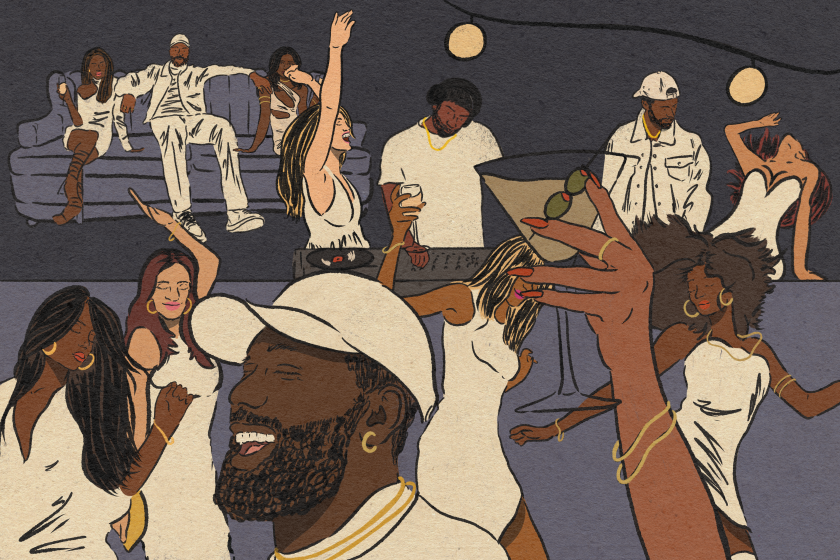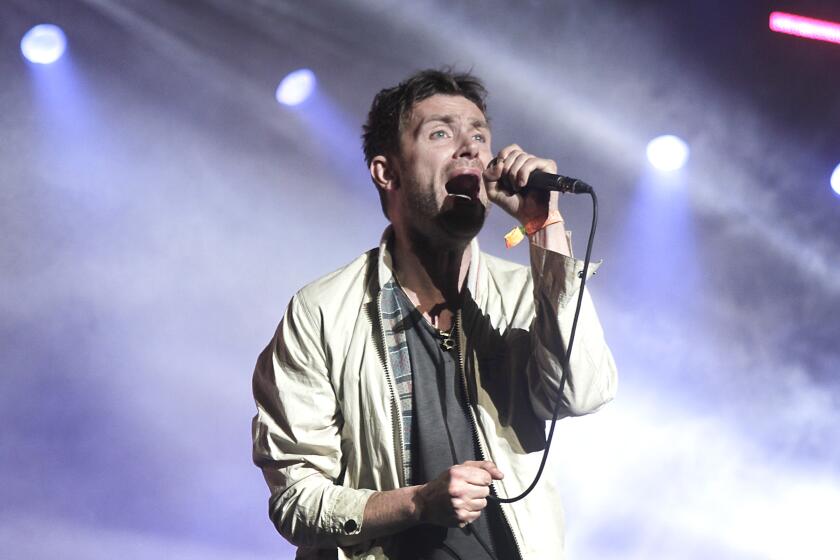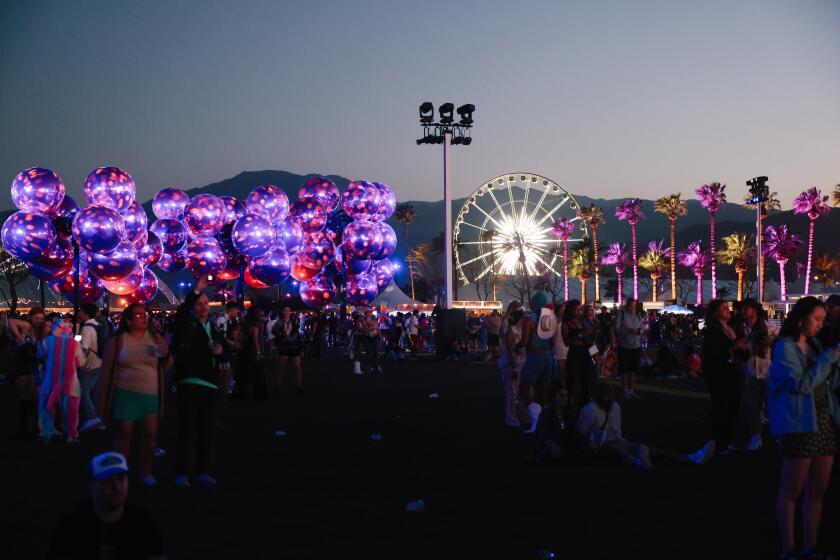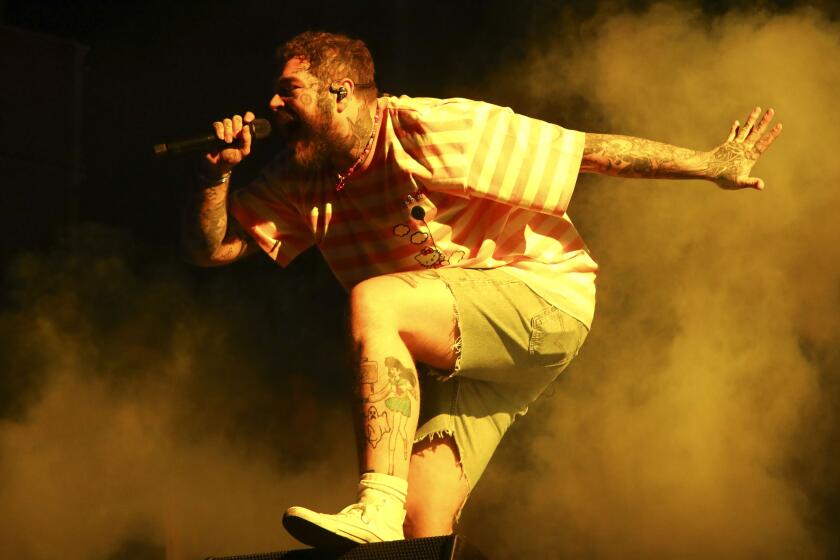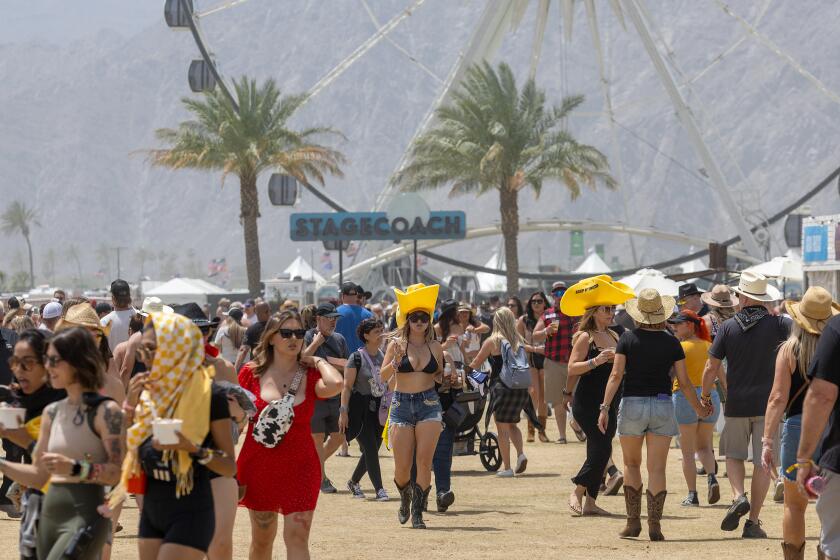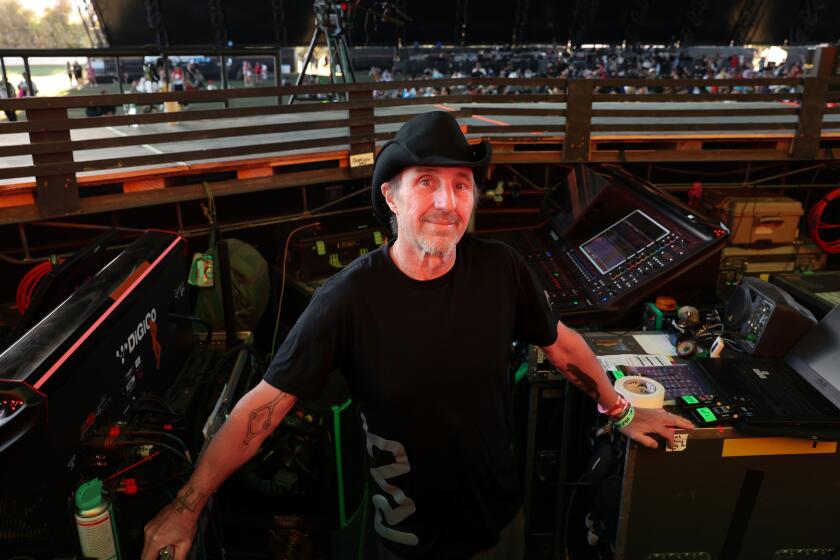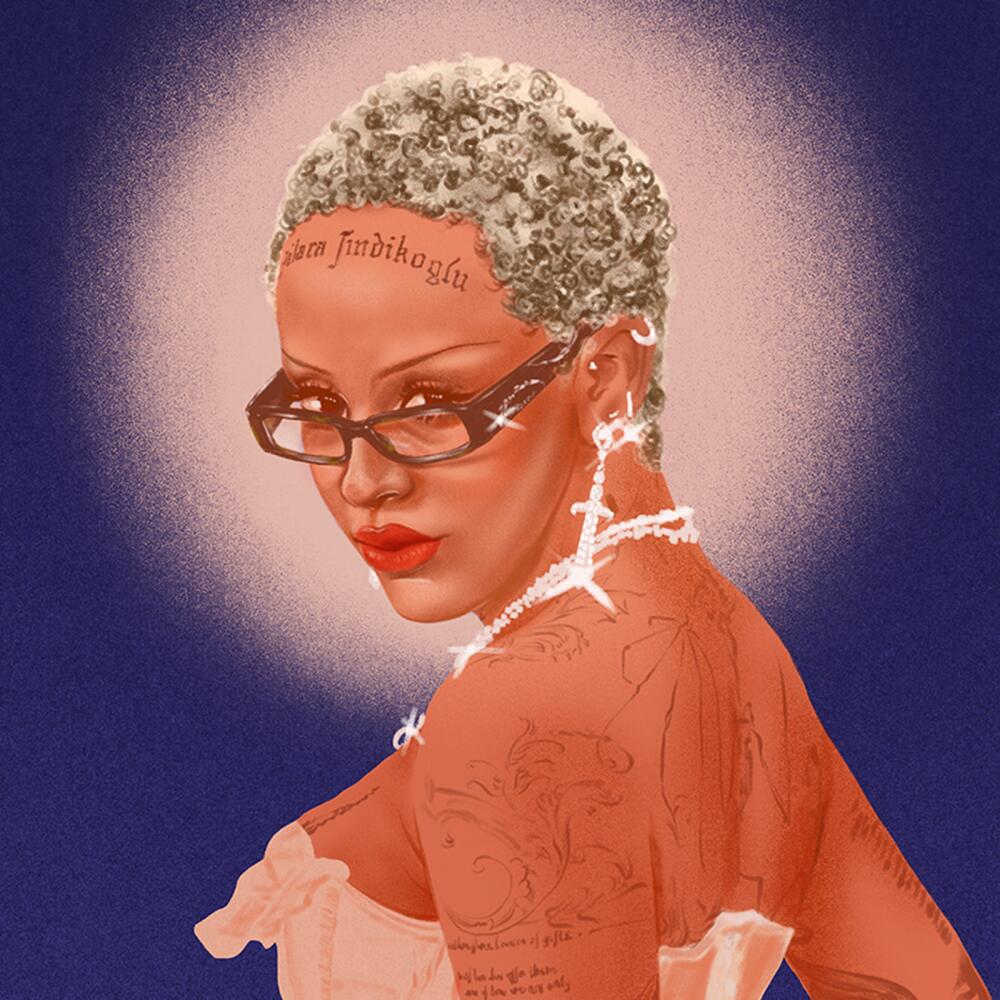
- Share via
In the late hours of Sunday evening, Doja Cat will close out the first weekend of the 23rd Coachella Valley Music and Arts Festival in front of 100,000 rapturous fans and millions more streaming at home. On the sprawling grounds of a former desert polo field, the multiplatinum Grammy Award winner will achieve another career landmark: she’ll become the first female rapper to headline the event, a distinction that puts a capstone on her rise to become the most prominent woman rapper ever raised in Los Angeles.
But this moment brings up a pressing question: Why did the first female Coachella headliner from L.A. need to skirt around the traditional hip-hop route to become a superstar? After all, while Doja Cat’s idiosyncratic art-pop fusion of rap and R&B defies easy categorization, her roots can be traced back to L.A.’s storied underground hip-hop scene in Leimert Park like Kaos Network’s Bananas where she freestyled and performed her early music. As a teen, she breakdanced and pop-locked in cyphers under the moniker “Lady Get Down” for the West Coast Pop Lockers. She also collaborated with local rappers Busdriver, Ill Camille and VerBS, who helped sharpen her musical talents. As a child, she was exposed to psychedelic jazz while living at Alice Coltrane’s Sai Anantam Ashram in Agoura Hills.
Her path to success underscores a deeper mystery at the heart of the city’s hip-hop culture: Why has Los Angeles failed to produce a major rap-first female superstar along the lines of Nicki Minaj and Cardi B from New York City, Saweetie from the Bay Area, Latto from Atlanta, GloRilla from Memphis or St. Louis’ Sexxy Red?
There’s no one single answer, but many theories are partially correct. The lack of women rappers crossing over into the mainstream involves a combination of systemic issues endemic to L.A.’s hip-hop climate: the legacy of gangsta rap and its extreme violence and misogyny that created a landscape inhospitable to women; the absence of super-producers who have championed female rappers and helped sustain their success; the inherent expectations and difficulties of being a female rapper in a male-dominated industry; and the failure of the artists themselves to capitalize on their initial momentum.
“There was a lot of times where a lot of people was wondering, ‘where are the female artists on the West Coast?’” asked South-Central rapper and Eazy-E protege Sylk-E. Fyne on the “I Only Touch Greatness” podcast last year.
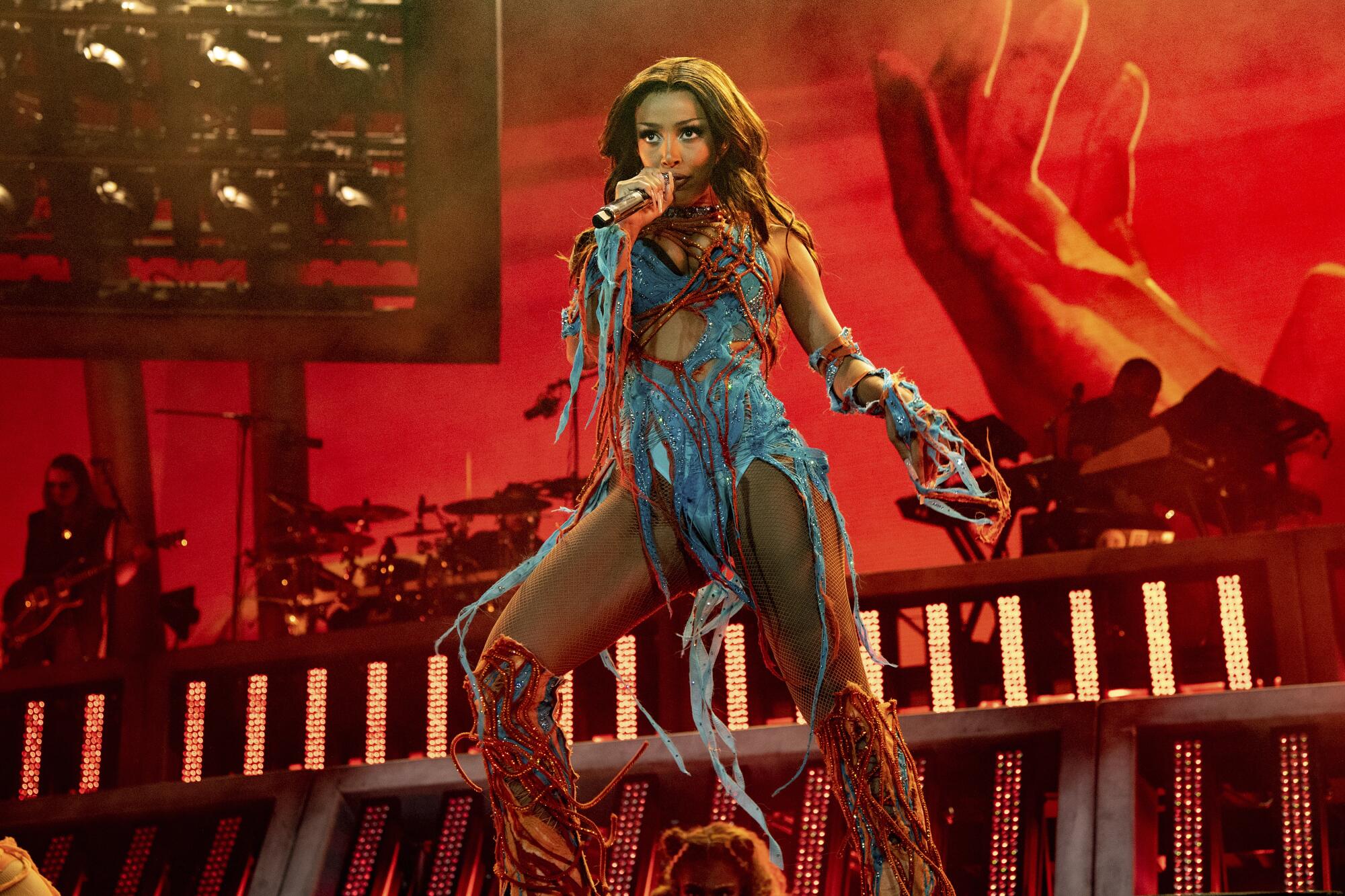
To understand how it happened requires taking it back to the beginning. In the ‘80s, before gangsta rap dominated the West Coast, there was electro-funk — a subgenre inspired by electronic and funk hybridists like Kraftwerk, Prince and Afrika Bambaataa. At the time, Uncle Jamm’s Army and its breakout star, the Egyptian Lover, supplied sex and freak-obsessed anthems to a generation of popping and locking teenagers. This was the hedonistic party-centric environment that incubated L.A.’s first major female rappers, J.J. Fad.
Around 1986, in the suburban Inland Empire, a teenage Juana Sperling hosted auditions at her mother’s house to find the members of her future girl group. She remembered feeling inspired by East Coast hip-hop and the carnal anthems spun at Uncle Jamm’s Army parties.
About an hour west in Compton, Eazy-E simultaneously formed N.W.A with Dr. Dre, Ice Cube, DJ Yella, Arabian Prince, and later, MC Ren. The blistering menace of their production, their shockingly aggressive and raunchy subject matter, and their cinematic narratives of L.A. street life ultimately created the blueprint for mainstream West Coast hip-hop.
But before they became recognized as the pioneers of gangsta rap, the members of N.W.A trafficked in the electro-rap tradition too. For all of the brandished sawed-off rifles and attacks on the police, the last track on 1988’s “Straight Outta Compton” was called “Something 2 Dance 2.” In this same year, Eazy-E’s Ruthless Records released the debut album from J.J. Fad, seeing the perfect way to fund N.W.A through Fad’s pop-friendly and commercially viable package.
After the trio of MC J.B. (Juana Burns-Sperling), Baby D (Dania Birks) and Sassy C (Michelle Franklin) aligned themselves to the nascent gangsta rap juggernaut, the label’s in-house producers Dr. Dre, DJ Yella and DJ Arabian Prince remixed their already hugely popular single “Supersonic,” adding heavy bass and electro-pop flourishes. But when they signed to Ruthless, Burns-Sperling says it was perhaps too fast for naive teens, “We didn’t have our own lawyers. We had Ruthless’ lawyers to go over the contracts and stuff with us. Baby D was a minor, and she didn’t have a parental signature.” The group didn’t feel “bamboozled or anything like that,” but in retrospect, “whether the contract was fair or not, I can’t really say, cause we didn’t have any idea,” says Burns-Sperling.

“Supersonic” went gold in 1988. Only three months after its release, J.J Fad members were among the first class of hip-hop artists to be nominated for a Grammy. But in the wake of “Supersonic” and “Straight Outta Compton’s” triumphs, West Coast hip-hop split in two. When it came time for J.J. Fad’s sophomore album, Dr. Dre claimed that he was too busy with other projects to handle production. By then, their feel-good up-tempo electronic rap was out of vogue. The misogynistic themes of L.A. gangsta rap could be aptly summarized by the title of a song on “The Chronic,” Dr. Dre’s triple-platinum solo debut: “Bitches Ain’t S—.”
“It caused a lot of problems in our community,” hip-hop archivist and educator Martha “MD” Díaz says, when asked about the long-term effects of the anti-women messages embedded in West Coast gangsta rap. “It’s great music, but the artists didn’t care how it programmed our young people, [or] how it affected how we see Black and brown women, [or] how we treat each other. It really dehumanized us.”
As the members of N.W.A and Dr. Dre’s protégé, Snoop Dogg, became household names, their music increasingly came under attack. Feminist scholars and music critics frequently criticized their lyrical disdain for women. In real life, Dr. Dre came under fire in January 1991 for physically assaulting Dee Barnes, the host of the popular video show “Pump It Up.” Dre pleaded no contest and was placed on two years probation, as well as having to do community service and pay a small fine. He later apologized for his actions.
“Twenty-five years ago I was a young man drinking too much and in over my head with no real structure in my life. However, none of this is an excuse for what I did,” Dre said in a 2015 statement released to the New York Times.
The mogul ended his comments with an apology “to the women” he’s hurt, without naming anyone specifically. “I deeply regret what I did and know that it has forever impacted all of our lives,” he said.
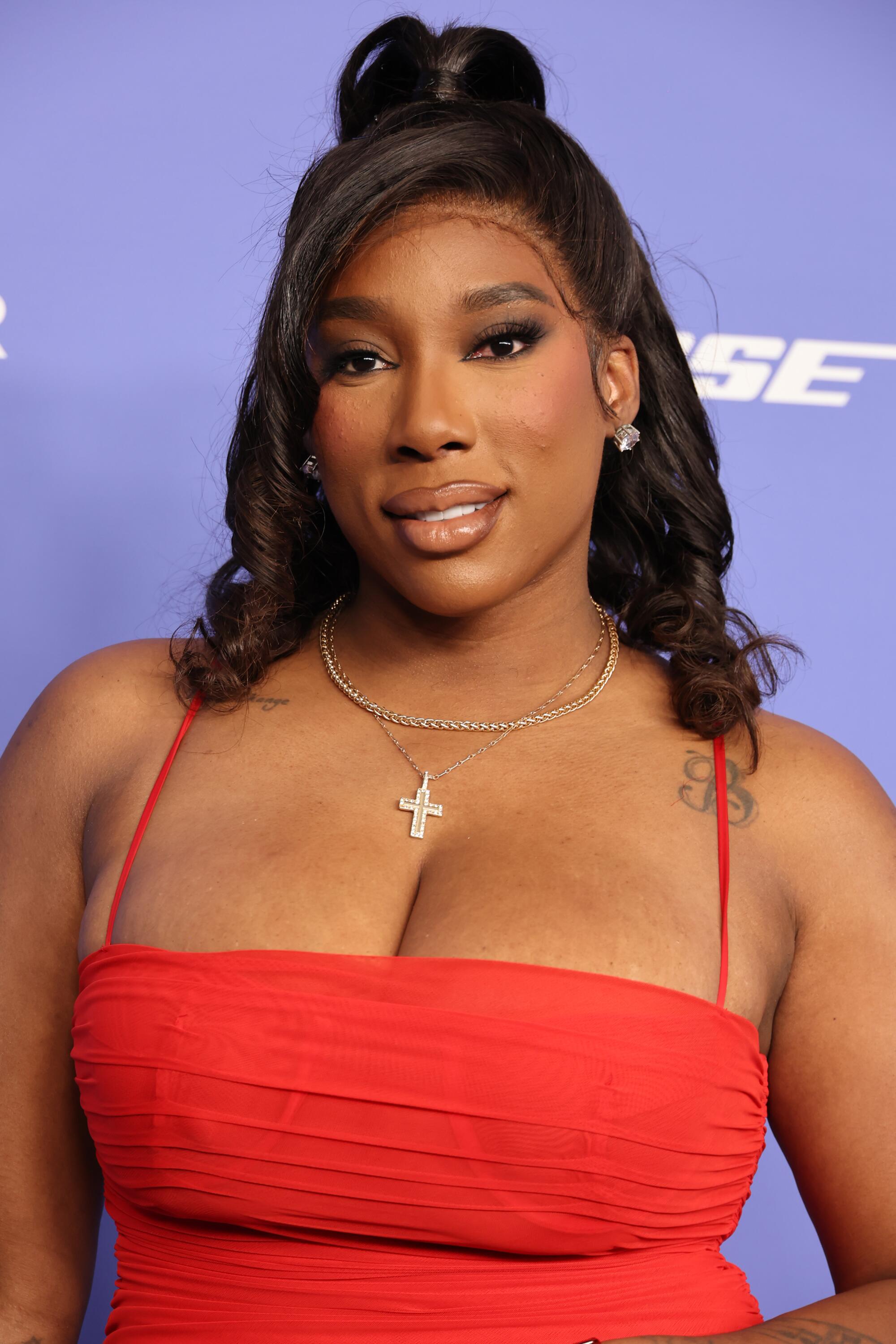
But at the time of the assaults, Dre’s actions set a precedent for the type of conduct that would be tolerated in such a regressive environment. This was clearly a boys’ club, where the only women allowed were those willing to explicitly or implicitly condone behavior hostile toward their own gender.
“You can Google the history of Dre’s abuse towards women. You can read the accusations from [Dre’s former collaborator and child’s mother] Michel’le,” says DJ Carisma, the sole female DJ on L.A.’s urban radio staple, Power 106 (105.9-FM). “That era was brutal.”
According to Michel’le, Dr. Dre inflicted a broken nose, cracked rib and five black eyes during the course of their lengthy relationship, which began in the late ‘80s, when she was 16 and he was 22. In a 2015 interview on the “Breakfast Club” radio program, the singer also accused Dre of once shooting at her with a gun. He missed her by inches, she said.
“[Dre’s] definitely responsible,” Carisma says, when asked about the glaring absence of women produced and co-signed by Dre during his four-decade run at the top of West Coast hip-hop. “When you also look at what’s going on with Diddy [Sean Combs], you see a pattern. These big dogs have no respect for women.”
Whether male or female, one of the most common routes to rap stardom involves developing a close working relationship and co-sign from a super-producer or an already entrenched MC. But for women rappers, it has been a particularly essential part of their path to success. Think of Timbaland introducing Missy Elliott to the world or Lil’ Wayne ushering Nicki Minaj into popular consciousness. The Notorious B.I.G. brought Lil’ Kim into the industry through his crew, Junior M.A.F.I.A., while Da Brat worked closely with Jermaine Dupri. Even one of the first breakout female rappers, Roxanne Shanté, came up under the aegis of Marley Marl and the Juice Crew.
“Even though technology was widely available, women usually weren’t producing their own music until much later on,” Díaz says. “That’s really important because the men were the ones that controlled who got put on.” And in Los Angeles that was even more significant because until the early years of the last decade, Dr. Dre acted as an almost omnipotent gatekeeper controlling the levers of L.A. commercial hip-hop.
Nor can you deny the impact of the street politics that define L.A. rap music either.
“We’re not a collaborative coast,” says Compton songwriter, producer and singer Brittany “Bee-B” Barber, who won a Grammy last year for her writing contributions on Robert Glasper’s “Black Radio III.” “It’s very territorial. But it’s only for women though. I’ve noticed that men eventually collaborate. Or they join rap groups or create teams. I think women get left out of that.”
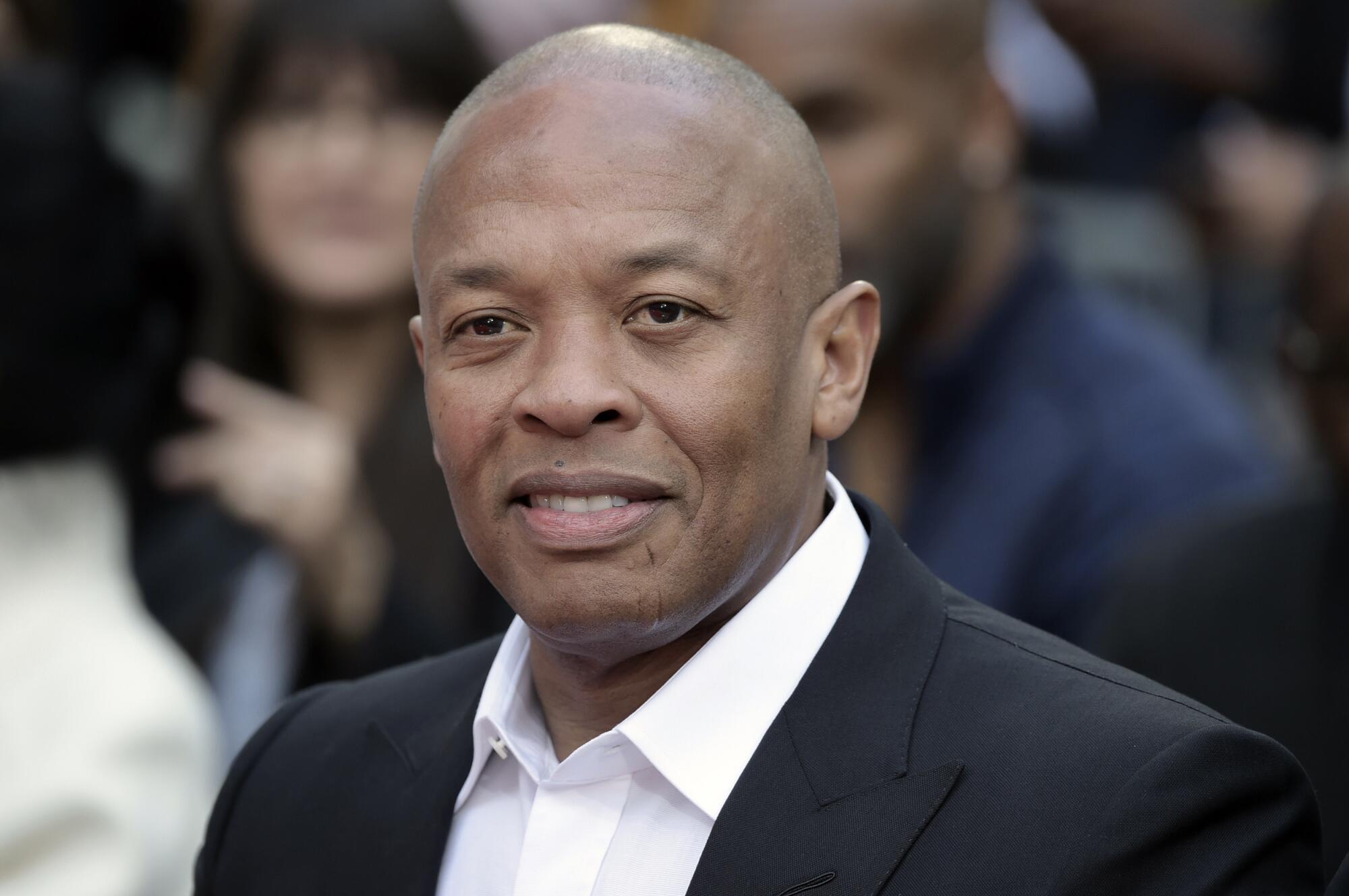
To Dre’s credit, he did work with a few female rappers at Death Row and Aftermath. The most commercially viable was Virginia transplant the Lady of Rage, who was molded in the gangsta rap archetype. She rocked “rough and tough” with her afro puffs (the title of her ubiquitous first single in 1994) and once famously punched a horse in the face defending Death Row in a fight.
“Women rappers from L.A. have historically been formulated in the image of the men — you know, the whole Dickie, plaid shirts, gangsta rap era,” says Charis Henry, a longtime music industry executive who worked closely with Eazy-E at Ruthless Records.
Despite a hit single and iconic appearances on “The Chronic” and “Doggystyle,” the Lady of Rage was never prioritized at Death Row. After waiting years in label purgatory her debut, “Necessary Roughness,” didn’t receive a release until 1997. By then, 2Pac was dead, Dre and Snoop Dogg had left the label, and Death Row boss Suge Knight was incarcerated. It failed to produce any hits and the album peaked at #32 on the Billboard charts.
The Lady of Rage wasn’t the only great L.A. female rap hope during the ‘90s. At the turn of the decade, 18-year-old, spaghetti-braided Yolanda “Yo-Yo” Whitaker made a showstopping debut on “It’s a Man’s World,” a standout track from Ice Cube’s classic, “AmeriKKKa’s Most Wanted.”
With mentorship from the N.W.A star, Yo-Yo delivered a trio of albums that received critical acclaim but failed to make a dent on the Billboard 200. Despite her fearless and empowering feminist raps — or perhaps because of them — the Compton native never garnered as much local radio play as her male peers. But in 1993, Yo-Yo seemed to be on the cusp of shattering the glass ceiling. Her “women can do it as well as the men” duet with Ice Cube, “The Bonnie & Clyde Theme,” became a fixture on Power 106 and “The Beat” (92.3-FM). It topped the Billboard Hot Rap Singles chart and she even nabbed a recurring role on the smash Fox show “Martin.”
But after it took three years for her label to release her follow-up, 1996’s “Total Control,” Yo-Yo walked away from pursuing a full-time rap career. She too had issues with the overtly masculine culture that predominated West Coast rap, “They couldn’t accept me for just being a woman. When I got pregnant, I just was like, ‘Oh, I can’t tell anybody’ … I was letting them down, that they let a girl in,” Yo-Yo said in a 2022 interview with PBS. “Now the money they’ve put into me, they got to … put it on hold, because it just seemed like a woman wasn’t supposed to be here.’

In her commentary, Yo-Yo alludes to another reason why female rappers supposedly don’t receive as many record deals: the costs inherent in breaking a female artist.
“They’re a lot more costly. I have heard that directly from labels,” says Power 106’s Carisma. “All major female artists are expected to look a certain way, think Beyoncé with her high-glam and Megan Thee Stallion with her dance crew, hair, makeup, the whole nine yards.”
These issues didn’t only impact female rappers with major-label deals, they affected underground female artists who never received the same level of interest as their male counterparts.
“The ‘90s was a very heterosexual and very masculine climate,” says Medusa the Gangsta Goddess, a longtime creative force in the Leimert Park underground hip-hop world.
“L.A. male rappers might think other female rappers are dope, but they would rather put on someone that is going to rap about where they’re coming from, something that they can tolerate and get behind.”
Medusa cut her teeth performing at the local hip-hop hubs the Good Life and Project Blowed, where artists were rewarded for thought-provoking lyricism, discouraged from using profanity, and eschewed violent themes despite coming from the same socioeconomic conditions as gangsta rappers. This countercultural movement ran concurrently but apart from the more commercially viable sex, drugs and violence-dominated rap world. It was an environment more conducive to and reflective of a traditionally feminine energy, but one that major-label king and queen makers usually avoided.
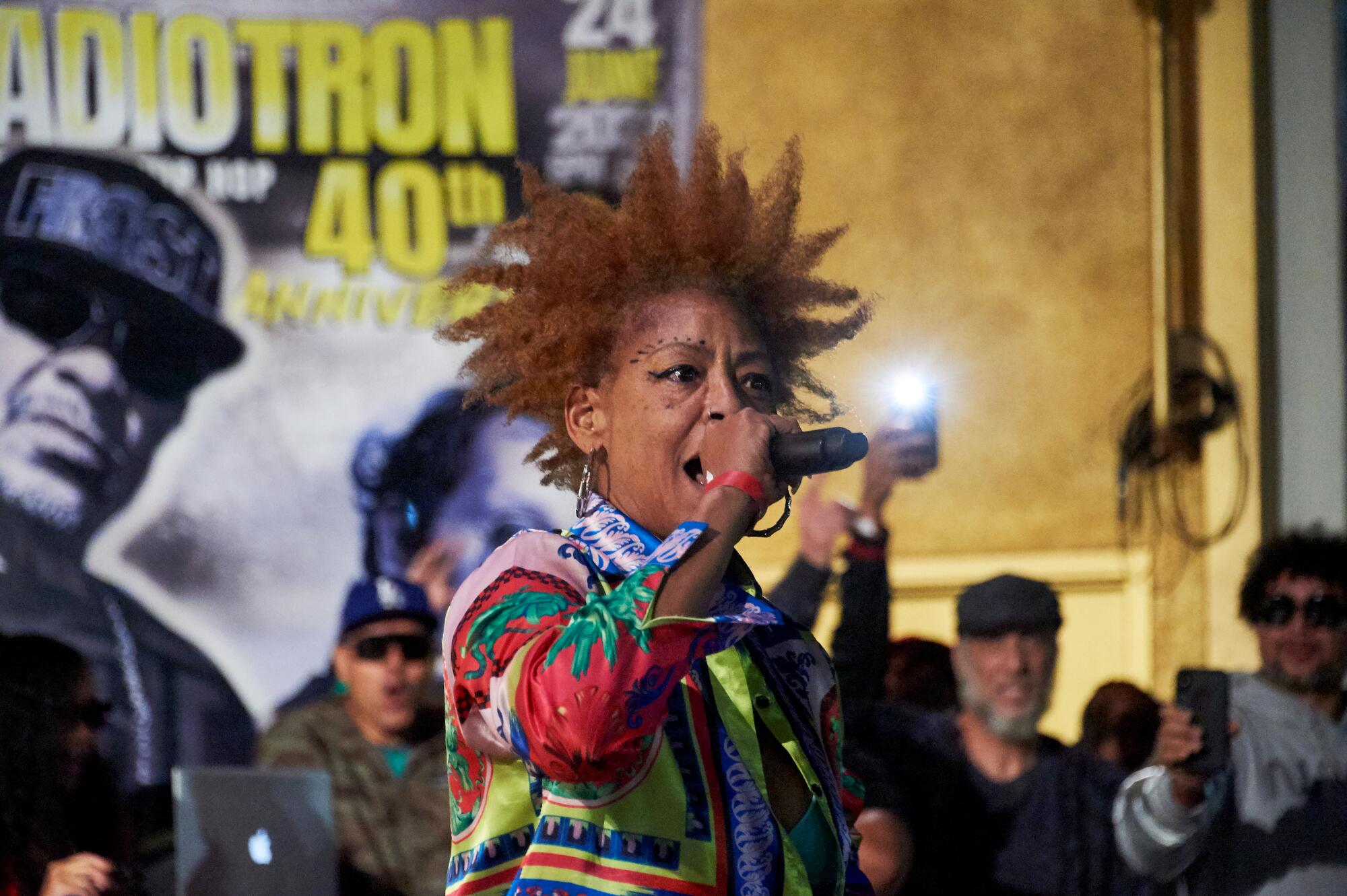
“[Dre] has bowed down and touched my feet, so has DJ Quik,” Medusa adds. “I’m like, you all know I’m here … I think the ego of a man gets in the way of allowing the woman to be exactly who she is.”
When weighing L.A. hip-hop’s history, it’s difficult to overlook how few female rappers have received a chance from the major producers who have dominated the city’s culture. In the nearly 30 years since Dre left Death Row to found his powerhouse Aftermath Entertainment imprint, he’s been heavily responsible for turning Eminem, 50 Cent, the Game, Anderson .Paak and Kendrick Lamar into household names. Yet the only prominent female rapper to work with Dre was Philadelphia’s Eve, who briefly signed to Aftermath in the late ‘90s and only appeared on a single song — on the 1998 “Bulworth” soundtrack (under the name Eve of Destruction). Shortly after leaving Dre’s company, Eve signed with Ruff Ryders and became one of the most commercially successful female rappers of all time.
In the late ‘00s, it seemed like a glory era of L.A. female rappers was about to emerge. With social media and the internet allowing artists to avoid the oligarchs that controlled local hip-hop, the jerkin’ movement took root among the region’s teenagers. Baggy khakis became skinny jeans, marine blue and blood red were swapped for fluorescent color schemes, and women numbered among the biggest stars of this dance-rap phenomenon. Soon to follow, was the subversive-minded Odd Future skateboarding goblins, formed by leader Tyler, The Creator, another L.A. rapper who will also headline Coachella alongside Doja Cat for the first time this year. Their lyrics were still explicit, but quite often the girls rapped the most obscene bars, inverting the previously entrenched power dynamics.
Groups like Pink Dollaz, Vixen Ent. and the Bangz ranked among the most technically vicious and virally popular artists of the jerkin’ craze, but only the latter received a record deal with a major label. Soon after, one of the two rappers in the Bangz, Korttney Elliott a.k.a. MC Ella Ann, was seriously wounded in a drive-by shooting and was unable to continue performing.
But jerkin’ incubated much of the next generation of L.A. hip-hop. Most notably, Y.G. and his producer DJ Mustard emerged as jerkin’ slowly morphed into ratchet, an up-tempo minimalist party rap subgenre. But the violence and misogyny in the songs remained the same, sometimes quite literally. One of Mustard and Y.G.’s first major breakthrough hits was a remake of the Dr. Dre and Snoop Dogg original, “Bitches Ain’t S—.” And for all of his success over the last decade, Mustard has neglected to release any full-length records from a Los Angeles female rapper.
At the same time that Doja Cat cut her teeth in the Leimert Park underground that had birthed Medusa a generation before, other female rappers started garnering attention in the middle years of the last decade. By now, Nicki Minaj was one of the most famous musicians on Earth, and most of the major rap capitals seemed to be producing their own female rap stars.
In the left-field and more heady spheres of the L.A. underground rap scene, Ill Camille and Vel the Wonder established themselves as formidable and incisive lyricists. Watts’ AshBashtharapper and Compton’s Azjah proved that there were plenty of viable heirs to the throne of Yo-Yo and the Lady of Rage. Most recently, Inglewood’s CUZZOS have emerged as one of the best groups in the city — regardless of gender — even shouting out the influence of Vixen and Pink Dollaz in a song from their latest EP.
Yet the fact remains that only Doja Cat has been able to break through to the level where she can top the bill at Coachella. And to do it, she had to go the pop route and from there, circle back to her Leimert Park freestyle roots on her last album, 2023’s “Scarlet.” But if you’re searching for two rappers who define the possibility and talent just waiting to be cultivated from L.A.’s deep female rap talent pool, the first names that come to mind are Cam & China, a pair of twins from Inglewood who were initially in Pink Dollaz before going solo in the early years of the last decade.

Despite receiving critical adulation and building a huge fanbase on social media, Cam & China are overly familiar with the hardships and exploitation that have historically plagued L.A. female rappers.
In 2016, Pitchfork gave Cam & China’s debut self-titled EP an 8.0 and called it “viscerally exciting rap music.” Around the same time, the duo’s manager started fielding collaboration requests from artists like Cardi B, and requests to perform on larger stages. But Cam says that their team never relayed these opportunities.
“[We were] just dealing with the wrong people, wrong management, wrong representation,” Cam says over a video call.
Just like in their Pink Dollaz days, they were unable to capitalize on their momentum. But unlike in the past, modern rappers are no longer beholden to major-label release schedules, the fickle tastes of radio and the ever-changing whims of producers. After resolving their contractual situation, Cam & China have proved that hard work and rare talent can transcend the obstacles facing female rappers. Their freestyles are constantly going viral on Instagram and TikTok, and Issa Rae tapped them for the soundtracks of her shows “Insecure” and “Rap Sh!t.”
This show of solidarity and recognition from their fellow L.A. native helped usher Cam & China through a rough patch. “[We were] living at the studio for like three months … but we [were] going hard with the freestyles,” says Cam. “There were no windows. You never got to really see sunlight. You didn’t know when it was dark. … So I started praying for a place where there were windows. And with the help of Issa Rae and everything that came after that, I was able to get a condo with several windows.”
The one-time teen prodigies from the jerkin’ era have now become certified legends with more than a decade of experience under their belt. And their continued career growth reflects the changing perceptions of female rappers from L.A. Only last month, Cam & China performed before their biggest audience yet — at the rap music festival Rolling Loud, just a few blocks from where they grew up in Inglewood.
“There’s a lot of female rappers rapping now, and this whole industry has changed for women in a really important way,” Cam says, remembering her historic place in the genre. “I love hip-hop. I love everybody who came before us. I appreciate everybody who came before us. … And [now] I’m a part of the change, and it feels good.”
More to Read
The biggest entertainment stories
Get our big stories about Hollywood, film, television, music, arts, culture and more right in your inbox as soon as they publish.
You may occasionally receive promotional content from the Los Angeles Times.
